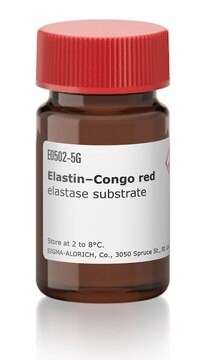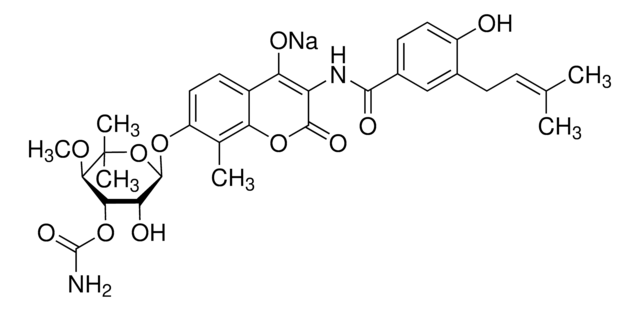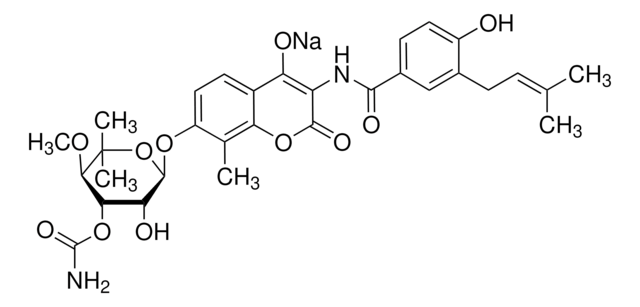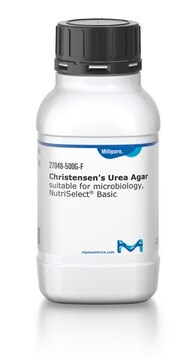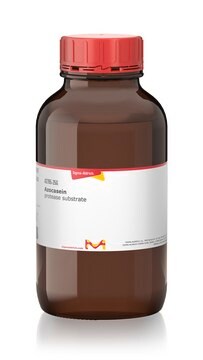Alle Fotos(1)
Wichtige Dokumente
D0690
DNA Gyrase from Escherichia coli
aqueous glycerol solution
Anmeldenzur Ansicht organisationsspezifischer und vertraglich vereinbarter Preise
Alle Fotos(1)
About This Item
Empfohlene Produkte
Biologische Quelle
Escherichia coli
Qualitätsniveau
Form
aqueous glycerol solution
Mol-Gew.
~374 kDa
Konzentration
≥2 unit/μL
Methode(n)
cell based assay: suitable
Anwendung(en)
cell analysis
Versandbedingung
dry ice
Lagertemp.
−70°C
Angaben zum Gen
Escherichia coli K12 ... gyrA(946614) , gyrB(948211)
Anwendung
DNA gyrase from Escherichia coli has been used in a study to investigate a comparative proteomic approach to better define Deinococcus nucleoid specificities. DNA gyrase from Escherichia coli has also been used in a study to investigate the role of the DnaK-ClpB bichaperone system in DNA gyrase reactivation.
Biochem./physiol. Wirkung
Can be used to supercoil plasmids.
DNA gyrase is supplied as an A2B2 holoenzyme. The molecular mass of subunit A is 97 kDa and that of subunit B is 90 kDa. It catalyzes the ATP-dependent introduction of negative supercoils into relaxed DNA. DNA gyrase has been successfully converted into a type II topoisomerase by mutagenesis experiments.
Einheitendefinition
One unit of gyrase activity will supercoil 0.5 micrograms of pBR-322 DNA in 30 minutes at 37 °C.
Sonstige Hinweise
Solution in 50% Glycerol containing Tris buffer, DTT and EDTA.
Lagerklassenschlüssel
10 - Combustible liquids
WGK
WGK 1
Flammpunkt (°F)
Not applicable
Flammpunkt (°C)
Not applicable
Hier finden Sie alle aktuellen Versionen:
Besitzen Sie dieses Produkt bereits?
In der Dokumentenbibliothek finden Sie die Dokumentation zu den Produkten, die Sie kürzlich erworben haben.
S C Kampranis et al.
Proceedings of the National Academy of Sciences of the United States of America, 93(25), 14416-14421 (1996-12-10)
DNA gyrase is unique among topoisomerases in its ability to introduce negative supercoils into closed-circular DNA. We have demonstrated that deletion of the C-terminal DNA-binding domain of the A subunit of gyrase gives rise to an enzyme that cannot supercoil
Alix Pantel et al.
Antimicrobial agents and chemotherapy, 56(4), 1990-1996 (2012-02-01)
Fluoroquinolone (FQ) resistance is emerging in Mycobacterium tuberculosis. The main mechanism of FQ resistance is amino acid substitution within the quinolone resistance-determining region (QRDR) of the GyrA subunit of DNA gyrase, the sole FQ target in M. tuberculosis. However, substitutions
Magali Toueille et al.
Journal of proteomics, 75(9), 2588-2600 (2012-03-27)
Compared to radiation-sensitive bacteria, the nucleoids of radiation-resistant Deinococcus species show a higher degree of compaction. Such a condensed nucleoid may contribute to the extreme radiation resistance of Deinococcus by limiting dispersion of radiation-induced DNA fragments. Architectural proteins may play
Teresa Lara-Ortíz et al.
Canadian journal of microbiology, 58(2), 195-199 (2012-01-24)
In Escherichia coli cells, an increase in temperature induces immediate DNA relaxation, followed by the fast recovery of DNA supercoiling. DNA gyrase, proteins synthesized during heat stress, and chaperone DnaK have been proposed to participate in this recovery. However, the
Valentina Monica et al.
Lung cancer (Amsterdam, Netherlands), 79(3), 228-235 (2013-01-02)
Thymic epithelial tumors include several entities with different biologic behavior. Chemotherapy is indicated in advanced disease, but limited data exist on gene expression correlation with the response to chemotherapeutic agents. A series of 69 thymic neoplasms (7 A-, 6 AB-
Unser Team von Wissenschaftlern verfügt über Erfahrung in allen Forschungsbereichen einschließlich Life Science, Materialwissenschaften, chemischer Synthese, Chromatographie, Analytik und vielen mehr..
Setzen Sie sich mit dem technischen Dienst in Verbindung.

